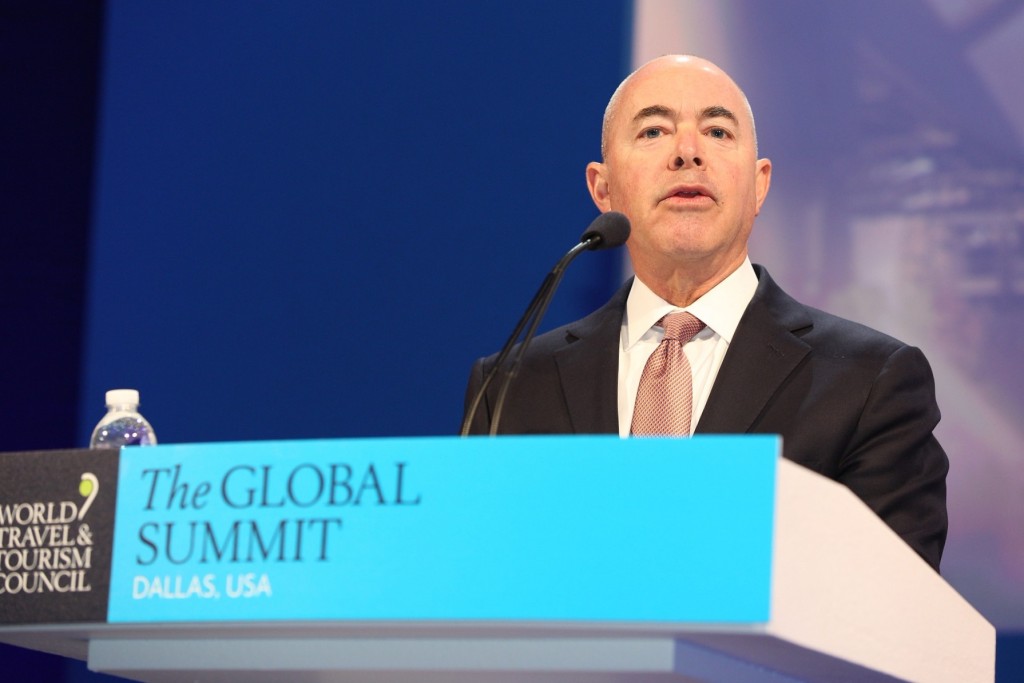
You might also like:
Alejandro Mayorkas, deputy secretary of Homeland Security, speaks at the WTTC Global Summit in Dallas April 7, 2016.
World Tourism & Travel Council / Flickr
Lines are getting ever longer at airports as the Transportation Security Administration struggles with staffing shortfalls and not-popular-enough programs meant to ease long waits.
The Department of Homeland Security knows that travelers are frustrated. And a representative told a gathering of travel and tourism professionals Thursday that the department is trying to boost security measures while being an ally to the industry.
“The enhancement of the security of the public can coexist with the advancement and the facilitation of travel and tourism,” said Alejandro Mayorkas, deputy secretary of Homeland Security. “There is a misconception that those two are mutually exclusive. The ability to advance both imperatives does present challenges.”
Speaking at the World Travel & Tourism Council Global Summit in Dallas, Mayorkas acknowledged that the department was focused on “plugging some vulnerabilities that we observed within the department in the screening of passengers” last year. A DHS Inspector General’s report last year found that the TSA failed to detect threats posed in 67 of 70 security tests.
That has resulted in changes to passenger screening and training of workers — but also longer waits.
“The public is growing restless as they see the longer lines and they experience longer wait times,” Mayorkas said. “We are working with the Department of Commerce in advancing a number of solutions and we are working with the private sector in doing so.”
Mayorkas described several needs and potential changes in the works during a short speech.
1. Airport Security, Pre-Checkpoint, Need More Attention
Last month’s attacks in Brussels, which included explosions near departure gates at the international airport, highlighted the need for more security in areas that don’t typically require screening.
“It is not just the screening of passengers that is of acute concern, but it is the airport as a destination, it is the airport as a location of mass assembly, that we must be acutely concerned about as well,” Mayorkas said.
2. Two Trusted Traveler Programs May Become More Like One
Officials are trying to increase the number of people who pay to enroll in two main trusted traveler programs: Global Entry, which is administered by U.S. Customs and Border Protection, and TSA PreCheck.
Both allow passengers to go through an expedited line without taking off their shoes or removing laptops or liquids.
“The ability to screen passengers in advance is of critical security concern and it is also the best way to facilitate the flow of individuals in advance of their flight,” Mayorkas said.
But the programs have separate processes for signing up and different fees. Global Entry members get TSA PreCheck benefits as well as expedited processing at customs when they arrive in the U.S.
“We have marketed those separately and I think we have to reconsider unifying their brand and frankly innovating more in our marketing of those endeavors so they are better known and our subscription levels only increase,” Mayorkas said.
3. The Government Borrowed Travel Industry Executives for Help
Homeland Security is using a program that the Department of Commerce came up with based on the notion that government bodies often spend a significant amount of time and money dreaming up ideas that don’t actually work.
Mayorkas said that through the “loaned executive program,” the department brought in executives from airlines, airports, travel associations, theme parks and destinations on a full-time basis for six months to help come up with better ways to provide public messaging, marketing, and line management.
“We developed collaboratively in a public-private partnership some critical solutions that we hope to unveil very soon,” he said.
4. Homeland Security Wants to Expand Preclearance in Foreign Airports
U.S. Customs and Border Protection is moving forward with 10 foreign airports that will have personnel on site to clear passengers before departure so they don’t have to go through customs upon arrival in the United States.
Already, 15 airports in six countries offer preclearance. Applications from the 10 in the works were accepted last year, and Mayorkas said the department would be soliciting greater interest from more airports in the coming weeks.
“This is a significant priority of ours now in the Department of Homeland Security,” he said.
5. Everyone Hates Its Name, But Visa Waiver Program Isn’t Going Anywhere
The visa waiver program got plenty of attention at the summit on Wednesday, but Mayorkas gave it a little more.
“Let me articulate quite unequivocally and quite clearly that we are absolutely committed to the vibrancy and continuation of the visa waiver program,” he said. “It is a program that unfortunately has the wrong name.”
He defended the security aspect of the program, which requires participating countries to have agreements with the United States about sharing traveler information. Those who want to visit the country through the initiative also must submit an application, he said, which provides information about the potential visitor.
So far, 38 countries are part of the program, and last year more than half of international visitors to the U.S. took part.
“We hope to strengthen that program as the days and weeks unfold,” Mayorkas said. “It has been under challenge in our legislature here in the United States. We are managing through those challenges successfully and we expect the continued vibrancy of the visa waiver program.”
Source: skift.com
